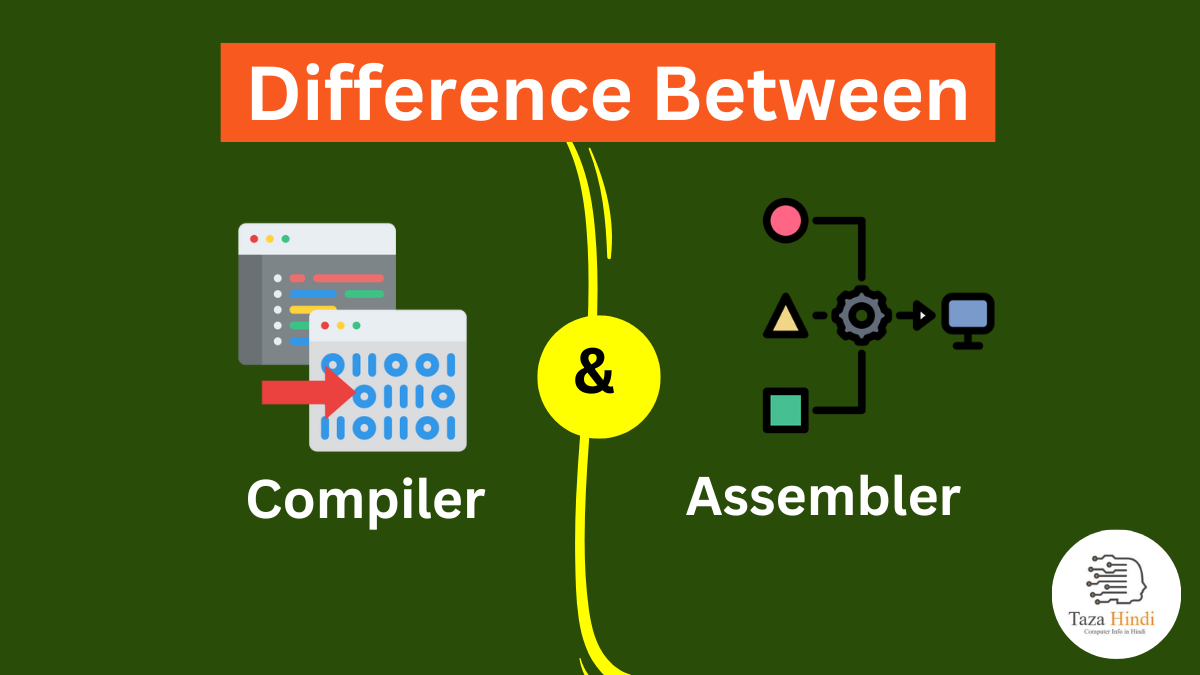Programming languages play a crucial role in software development, enabling programmers to communicate instructions to computers effectively. However, these high-level programming languages need to be translated into machine-understandable instructions. This is where compilers and assemblers come into the picture. In this tutorial you can clear your doubt about what are the main difference between Compiler and Assembler, their roles in the software development process and you may also learn what is Compiler and Assembler, their uses, benefits of using Compiler and Assembler.
Importance of programming languages and their role in software development
Before delving into the specifics of compilers and assemblers, it is essential to understand the significance of programming languages in software development. Programming languages provide a structured and human-readable way to write instructions that can be executed by computers. They act as a bridge between human programmers and machines, enabling the development of complex software applications.
What is a Compiler?
A compiler is a software tool that translates high-level programming language code into machine code that can be executed directly by a computer’s processor. It performs a series of tasks, including lexical analysis, syntax analysis, and code generation, to convert the entire source code into an executable program. The compilation process involves analyzing the code’s structure, identifying errors or inconsistencies, and generating optimized machine code.
Role of a Compiler in the software development process
The compiler plays a vital role in the software development process. It acts as a translator, ensuring that the high-level code written by programmers can be executed efficiently by the target hardware. The compiler converts the entire source code into machine code, which eliminates the need for interpretation during runtime, resulting in faster program execution.
Also Read : How to Improve Your Programming Skills in 2023
What are the compilation process?
The compilation process consists of several stages, including lexical analysis, syntax analysis, and code generation. Lexical analysis involves breaking the source code into a sequence of tokens, such as keywords, identifiers, and operators. Syntax analysis verifies the syntax and structure of the code, ensuring it adheres to the rules defined by the programming language. Code generation involves transforming the syntactically correct code into optimized machine code that can be executed by the target hardware.
Benefits of using a compiler
Using a compiler offers several benefits in software development. Firstly, it allows programmers to write code in high-level languages, which are more intuitive and easier to understand compared to low-level languages. Compilers also perform optimizations during the code generation process, resulting in faster and more efficient execution of programs. Furthermore, compilers provide portability, as the generated machine code can be executed on different hardware platforms without modification.
Also Read : How to Learn the Basics of C Sharp Programming
Popular compilers and their usage
Several popular compilers are widely used in the software development industry. For instance, GCC (GNU Compiler Collection) is a widely-used compiler suite that supports multiple programming languages like C, C++, and Fortran. It is open-source and is compatible with various operating systems. Another example is the Clang compiler, which is known for its excellent diagnostics and support for the C, C++, and Objective-C languages. It is commonly used in the LLVM infrastructure and offers high performance.
What is an Assembler?
Compilers translate high-level languages, assemblers are used to convert assembly language code into machine code. Assembly language is a low-level programming language that provides a symbolic representation of the machine code instructions. Assemblers perform the task of translating assembly language instructions into binary machine code that can be executed by the computer’s processor.
Purpose of Assembler in the software development process
The primary purpose of an assembler is to bridge the gap between assembly language and machine code. Assemblers convert assembly instructions, which are easier for programmers to write and understand, into machine-understandable instructions. This allows programmers to write code at a more granular level, giving them greater control over the hardware resources and optimizations.
Also Read : How to Learn Variables of C Sharp Programming
What are the assembly process ?
The assembly process involves translating assembly language code into machine code. It follows a straightforward process of converting each assembly instruction into its corresponding machine code representation. This translation involves replacing mnemonic instructions with their binary equivalents and resolving memory addresses and operands. The output of the assembly process is a binary executable file that can be directly executed by the target hardware.
Benefits of using an Assembler
Assemblers offer several advantages in software development, especially when working with low-level programming. Firstly, they provide a higher level of control over the hardware resources, allowing programmers to fine-tune performance and optimize code for specific architectures. Assemblers also facilitate the development of system-level software, device drivers, and embedded systems, where direct hardware manipulation is necessary. Additionally, working with assembly language can enhance programmers’ understanding of the underlying computer architecture and instruction set.
Popular Assemblers and their usage in different hardware architectures
There are various assemblers available, each designed for specific hardware architectures. NASM (Netwide Assembler) is a widely-used assembler that supports x86 and x86-64 architectures. It is popular among developers working on Intel-based systems and provides extensive macro support and a flexible syntax. Another notable example is GAS (GNU Assembler), which is part of the GNU Compiler Collection (GCC). GAS supports multiple architectures, including x86, ARM, MIPS, and PowerPC. It is often used in conjunction with GCC for its compatibility and robustness.
Also Read : How to Learn Data Types of C Sharp Programming
Difference between Compiler and Assembler
Although compilers and assemblers are both used in software development, there are fundamental differences between them, these are given below:
| Compiler | Assembler |
| Compilers translate high-level programming languages into machine code, allowing programmers to work with more abstract concepts and constructs. | Assemblers work with assembly language, which provides a direct representation of machine instructions and requires a deeper understanding of the underlying hardware. |
| Compilers accept input in the form of high-level programming languages, such as C, C++, Java, or Python. They perform a comprehensive analysis of the entire source code, including lexical, syntax, and semantic analysis, before generating optimized machine code. | Assemblers take assembly language as input, which is a low-level symbolic representation of machine code instructions. |
| The output generated by compilers is machine code, which is directly executable by the target hardware. This eliminates the need for interpretation during runtime, resulting in faster execution. | Assemblers generate machine code specifically from assembly language instructions, preserving the low-level nature of the code. |
| Compilers provide higher-level control and optimization features. They perform optimizations during the code generation process, such as dead code elimination, loop unrolling, and constant folding, to improve the efficiency and performance of the resulting machine code. | Assemblers, while offering more direct control over hardware resources, generally do not provide the same level of sophisticated optimization techniques as compilers. |
Also Read : How to create a website without paying any money
Conclusion
Compilers and assemblers are indispensable tools in the software development process. Compilers translate high-level programming languages into machine code, offering abstraction, portability, and optimization. Assemblers, on the other hand, convert assembly language code into machine code, providing more control over hardware resources and low-level optimizations. Understanding the differences between compilers and assemblers is crucial for programmers to choose the appropriate tool based on their programming language, hardware architecture, and level of control required.
FAQs
-
Can a compiler and an assembler be used together?
Yes, it is common to use both a compiler and an assembler in the software development process. Compilers are used to translate high-level code into machine code, while assemblers are used when working with assembly language and low level programming. In some cases, programmers may write performance-critical sections of code in assembly language and integrate them into their high-level language codebase using inline assembly or separate assembly files.
-
Can compilers and assemblers handle different operating systems?
Yes, compilers and assemblers can handle different operating systems. However, the generated machine code needs to be compatible with the target operating system and hardware architecture. Compilers and assemblers often have options or flags to specify the target platform, allowing developers to generate code that is compatible with specific operating systems and hardware configurations.
-
Are compilers and assemblers used only in software development?
While compilers and assemblers are primarily used in software development, they also have applications in other areas. Compilers are used in the development of programming languages, where they translate the language specifications into executable code. Assemblers, besides their use in software development, are essential in areas such as reverse engineering, where understanding and modifying the machine code are necessary.
-
Do compilers and assemblers have debugging capabilities?
Compilers and assemblers themselves do not typically offer extensive debugging capabilities. However, they may generate debugging information along with the machine code, such as line numbers and variable names, which can be used by separate debugging tools. Integrated Development Environments (IDEs) often provide debugging features that can be used in conjunction with compilers and assemblers for efficient code debugging.



